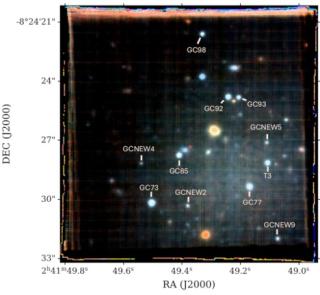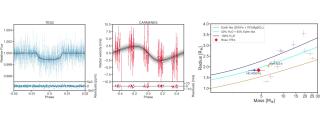It may interest you
-
 The solar corona—the outermost layer of the Sun’s atmosphere—is extremely hot and very low in density. One of the main challenges in solar physics is understanding why the corona reaches temperatures of over a million degrees. This heating is believed to be closely related to the Sun’s magnetic field. However, quantifying the coronal magnetic field is difficult because the light emitted by the corona is extremely faint, and its polarization signals, which encode the information on the magnetic field, are subtle. Thanks to recent advances in technology, telescopes like the Daniel K. InouyeAdvertised on
The solar corona—the outermost layer of the Sun’s atmosphere—is extremely hot and very low in density. One of the main challenges in solar physics is understanding why the corona reaches temperatures of over a million degrees. This heating is believed to be closely related to the Sun’s magnetic field. However, quantifying the coronal magnetic field is difficult because the light emitted by the corona is extremely faint, and its polarization signals, which encode the information on the magnetic field, are subtle. Thanks to recent advances in technology, telescopes like the Daniel K. InouyeAdvertised on -
 O ne of the key challenges in astronomy is to measure accurate distances to celestial objects. Knowing distances is crucial since it allows us to measure physical properties such as size, mass and luminosity. Since we can’t go out and use a tape-measure, a range of different approaches have been developed. Many of these approaches rely on using “standard candles”. Standard candles are objects (for example stars or supernovae) for which we know their intrinsic ”true” brightness. Once we know this, then their observed brightness compared to their intrinsic brightness gives us a distance to theAdvertised on
O ne of the key challenges in astronomy is to measure accurate distances to celestial objects. Knowing distances is crucial since it allows us to measure physical properties such as size, mass and luminosity. Since we can’t go out and use a tape-measure, a range of different approaches have been developed. Many of these approaches rely on using “standard candles”. Standard candles are objects (for example stars or supernovae) for which we know their intrinsic ”true” brightness. Once we know this, then their observed brightness compared to their intrinsic brightness gives us a distance to theAdvertised on -
 The TESS (Transiting Exoplanet Survey Satellite) mission has discovered many exoplanet candidates that need to be confirmed and characterized from the ground. One of them orbits Ross 176, a K-type dwarf star, where we have identified a promising hot “water-world” candidate. Using spectroscopic observations with the CARMENES instrument, we confirmed the planetary nature of the signal detected by TESS and estimated the planet’s mass. To improve the analysis, we applied an advanced statistical method called Gaussian Process, which allowed us to separate the star’s own variability (quite strongAdvertised on
The TESS (Transiting Exoplanet Survey Satellite) mission has discovered many exoplanet candidates that need to be confirmed and characterized from the ground. One of them orbits Ross 176, a K-type dwarf star, where we have identified a promising hot “water-world” candidate. Using spectroscopic observations with the CARMENES instrument, we confirmed the planetary nature of the signal detected by TESS and estimated the planet’s mass. To improve the analysis, we applied an advanced statistical method called Gaussian Process, which allowed us to separate the star’s own variability (quite strongAdvertised on
